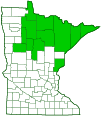Common Rim Lichen
(Lecanora pulicaris)
Conservation • Description • Ecology • Distribution • Taxonomy
Conservation Status |
|
|||||||
| IUCN Red List | not listed |
|||||||
| NatureServe | NNR - Unranked |
|||||||
| Minnesota | not listed |
|||||||
Description |
||
Lecanora pulicaris is a common rim lichen appropriately but unimaginatively named Common Rim Lichen. It occurs in Europe, western Asia, and North America. It is common in northeastern and north-central Minnesota, but it is absent from the remainder of the state. Common Rim Lichen is extremely variable in both ecology and morphology. It grows on both the bark and the wood of trees. It prefers trees with acidic bark. In Minnesota, these include pine, spruce, and tamarack. However, it frequently grows on trees with slightly acidic bark, including birch, hawthorn, oak, alder, basswood, and ash. It sometimes grows on trees with more neutral bark, including elm and willow, especially in areas that have been affected by acid rain. It has also been collected on serpentinite rock. The vegetative body (thallus) is crust-like (crusticose). It is usually thin, smooth, opaque, and continuous. It does not have a tough outer layer (ecorticate), it is not covered with a thin powdery substance (epruinose), and it does not develop asexual reproductive granules as it ages (esorediate). It is sometimes thicker, rough, and divided into islands separated by cracks (areolate). The areoles may be thick or thin, and they may be flat or be covered with wart-like elevations. The elevations may be moderate-sized (verrucose) or small (verruculose). The color may be yellowish white to yellowish gray or whitish gray to gray. The margin is indistinct. Spore-bearing reproductive structures (apothecia) are common. They are disk-like and moderate sized, 1⁄64″ to 1⁄16″ (0.3 to 1.5 mm) in diameter. They may be stalkless or slightly constricted at the base causing them to appear almost stalked. The discs can be pale brown, reddish-brown, brown, dark brown, blackish brown, or black. The disc margins are persistent, and they are the same color as the thallus. They may be thin, relatively thick, or even prominent. They are smooth, not scalloped or wavy. |
||
Similar Species |
||
Ecology |
||
Substrate |
||
Trees |
||
Growth Form |
||
Crusticose |
||
Habitat |
||
Bark |
||
Hosts |
||
Pine, spruce, beech, and mountain ash |
||
Distribution |
||||
|
Sources |
|||
| 2/1/2024 | ||||
Occurrence |
||||
Common |
||||
Taxonomy |
|||
| Kingdom | Fungi (Fungi) | ||
| Subkingdom | Dikarya | ||
| Phylum | Ascomycota (Sac Fungi) | ||
| Subphylum | Pezizomycotina (Sac Fungi and Lichens) | ||
| Class | Lecanoromycetes (Common Lichens) | ||
| Subclass | Lecanoromycetidae (Shield Lichens, Sunburst Lichens, Rosette Lichens, and Allies) | ||
Order |
Lecanorales (Shield Lichens, Rim Lichens, and Allies) | ||
Family |
Lecanoraceae (rim lichens, disc lichens, and allies) | ||
Genus |
Lecanora (rim lichens) | ||
| Mycobiont | Lecanora pulicaris | ||
| Photobiont | |||
Synonyms |
|||
Lecanora chlorona Lecanora coilocarpa Lecanora pinastri Lecanora subfusca var. pinastri Lecanora subfusca var. pulicaris Patellaria pulicaris |
|||
Common Names |
|||
Common Rim Lichen |
|||
Glossary
Areolate
In mushrooms, the cap surface cracked creating block-like patches similar to dried mud. In lichens: the surface sharply divided into islands separated by cracks.
Apothecium
An open, disk-shaped or cup-shaped, reproductive structure, with spore sacs on the upper surface, that produces spores for the fungal partner of a lichen. Plural: apothecia.
Crusticose
Crusty; referring to lichens in such close contact with the rock surface (substrate) that it appears sprayed on like paint.
Pruina
On lichens, a thin, powdery or crystaline deposit on the surface of the thalus. It may appear chalky or frosty, and is usually white, gray, or bluish.
Soredium
An asexual reproductive structure of a lichen in the form of a tiny dull granule on the thallus surface that can be easily brushed off. It consists of a cluster of algal cells (the photobiont) wrapped in fungal filaments (the mycobiont), but without an outer layer of protective tissue (cortex). Plural: soredia.
Thallus
In lichens: The vegetative body of a lichen composed of both the alga and the fungus. In liverworts: a flat, relatively undifferentiated plant body. Plural: thalli.
Visitor Photos |
|||||
Share your photo of this lichen. |
|||||
| This button not working for you? Simply email us at info@MinnesotaSeasons.com. Attach one or more photos and, if you like, a caption. |
|||||
MinnesotaSeasons.com Photos |
|||||
|
|||||

Slideshows |
||

Visitor Videos |
|||
Share your video of this lichen. |
|||
| This button not working for you? Simply email us at info@MinnesotaSeasons.com. Attach a video, a YouTube link, or a cloud storage link. |
|||
Other Videos |
|||

Visitor Sightings |
|||||
Report a sighting of this lichen. |
|||||
| This button not working for you? Simply email us at info@MinnesotaSeasons.com. Be sure to include a location. |
|||||
|
|||||
MinnesotaSeasons.com Sightings |
|||||
|
|||||

Created: 2/2/2024
Last Updated:
